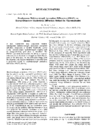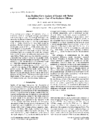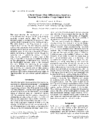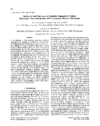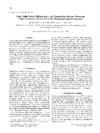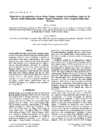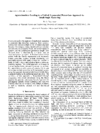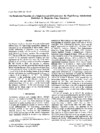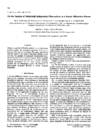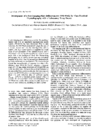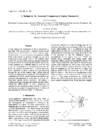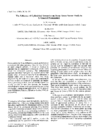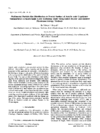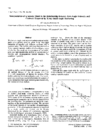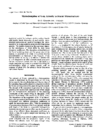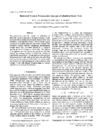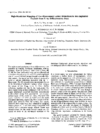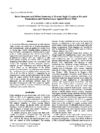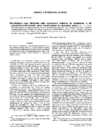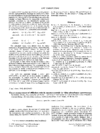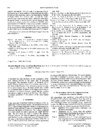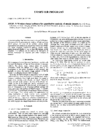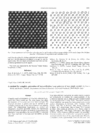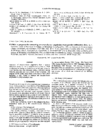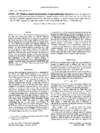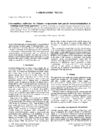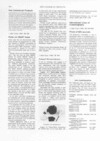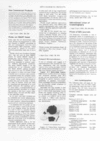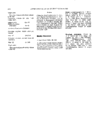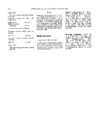issue contents
December 1995 issue

Cover illustration: The observed X-ray diffuse scattering in the (h0l) section of 1,3-dibromo-2,5-diethyl-4,6-dimethylbenzene. Courtesy of T. R. Welberry and B. D. Butler.
research papers
A new method for collecting multiwavelength anomalous diffraction data on protein crystals is demonstrated. This method employs a curved-crystal monochromator to measure Bijvoet and dispersive reflections simultaneously.
X-ray Rocking-Curve Analysis of Crystals with Buried Amorphous Layers. Case of Ion-Implanted Silicon
Ion implanation of a silicon single crystal at a sufficiently large dose can produce an amorphous layer beneath the crystal surface, which causes interesting X-ray interference phenomena. These are discussed here and it is shown that the analysis of rocking curves is unable to give unambiguous values for the rigid outward displacement of the crystalline surface induced by the expansion in the buried amorphous layer.
A polymer fibre diffractometer is described that uses a small-area X-ray-sensitive charge-coupled device as its detector. Through multiple snapshots at different goniometer settings and the suitable transformation of each image, a complete undistorted representation of cylindrically averaged reciprocal space is obtained.
The composition, crystallography, spatial distribution and size distribution of small inclusions, average size about 1 micrometre, dispersed within synthetic diamonds several mm in diameter, have been examined. Both metallic and silicate phases were identified in included bodies.
X-ray triple crystal diffractometry and transmission electron microscopy have been applied to structure characterization of heavily mismatched semiconducting epitaxic systems. It was shown that misfit dislocations broaden the X-ray reflections in the direction normal to the reciprocal-lattice vector H, while threading dislocations cause peak broadening in both directions, parallel and perpendicular to H.
This paper deals with the quantitative determination of low-phase volume fraction in ferro-silicon alloys by the Rietveld profile-refinement method. Neutron diffraction is compared with imaging analysis, chemical analysis and phase-diagram calculation.
A unified exponential/power-law equation is developed that describes small-angle scattering from complex systems. The approach describes mass and surface fractals as well as materials with multiple levels of structure.
The resolution function of a triple-crystal diffractometer for high-energy synchrotron radiation in a dispersive setting is calculated and compared with experimental data.
A method for deriving the number of statistically independent observations in a powder diffraction pattern is described.
An automatic diffractometer of Weissenberg-camera type with imaging plates and an adjustable multilayer-line-screen system has been newly developed and its performance and practical measurements are presented.
A new method of comparison of lattice parameters is described. It uses standard double-crystal diffractometers and is capable of precision similar to that of the Bond method.
A model is proposed to determine by X-ray diffraction the six independent components of the stress tensor for cylindrical symmetry.
A program to evaluate the solution scattering from macromolecules with known atomic structure, taking into account the hydration shell, is presented.
X-ray scattering and model calculations have given evidence of a four-membered multimodal particle-size distribution of surface-fractal acrylic acid copolymer nanoparticles in solution. Maximum-entropy methods are used for data evaluation.
The condition for appearance of the iso-zero-angle-intensity (isoZAI) point has been theoretically derived.
The absorption of scattered X-rays is theoretically analysed for samples with fractal internal surface.
The addition of a coaxial aperture at the entrance of a straight cylindrical tube lowers the acceptance and reduces the average number of reflections relative to unrestricted transmission. The effect of nonperfect reflectivity of the tube inner surface is to increase the transmission as a function of tube radius.
Two-dimensional lattice distortions in near-surface layers of silicon (111) crystals implanted with B+ ions of 100 KeV energy through a periodic oxide mask pattern have been mapped out with spatial resolutions of 0.016 and 0.265 micrometre in the depth and lateral directions, respectively, using triple-crystal synchrotron X-ray diffractometry data.
Calcia-and yttria-stabilized zirconia show a different ordering behaviour at high temperatures and under an applied electric field. Only in CaO-ZrO2 is an ordering process between microdomains supported by an enhanced ionic motion.
The parasitic scattering of several materials used as windows in SAXS experiments has been measured. Based on the criteria of high strength, high transmission and low parasitic scattering, the best material was found to be IF-1 beryllium.
short communications
The use of the synchrotron Laue diffraction technique with a slit-collimated incident beam as a structural probe to examine solid-state phase transformations in single crystals is presented. The utility of the method is demonstrated through a study of the paraelectric-to-ferroelectric phase transition in ammonium sulfate at 223 K.
A simple quantitative method, based on visible absorbances in the crystal measured by digital image analysis, is described for measuring diffusion and binding in the crystal.
A procedure has been developed for the cross-rotation function that uses a truncation of the calculated Patterson by means of an envelope that follows the shape of this Patterson. Test calculations indicate that the resulting orientation is nearly as accurate as that obtained after Patterson correlation refinement of the cross-rotation function orientation.
computer programs
Software has been developed under an X-Windows environment for high-resolution electron microscopy. The program can be very useful for quantitative geometrical analysis of atomic images.
An increase in the potential of the back-reflection Laue technique is achieved with the computational method proposed for the complete simulation of patterns.
A program for the reliable estimation of structure-factor amplitudes from powder diffraction data is described.
WPDB provides efficient storage and allows efficient querying of macromolecular structures derived from the Protein Data Bank (PDB). The geometric and sequence properties of structures can be analysed individually or through comparative analysis.
laboratory notes
A straight glass capillary is used for distance compensation at the spatially inaccessible direct-drive side of rotating-anode X-ray generators. Construction and alignment are discussed and its suitability is demonstrated by a precession photograph of hen egg lysozyme.
cryocrystallography papers
A crystal-mounting device for cryogenic macromolecular crystallography has been developed by slicing capillary tubes.
new commercial products
Free 

international union of crystallography
Free 

books received
Free 

Free 



 journal menu
journal menu









